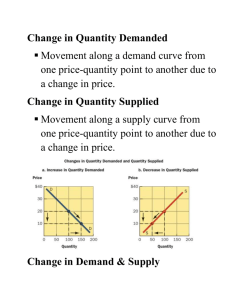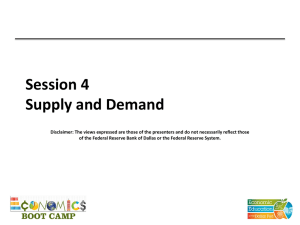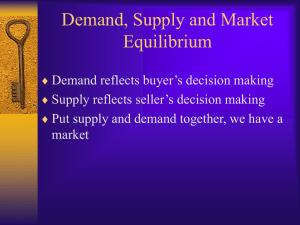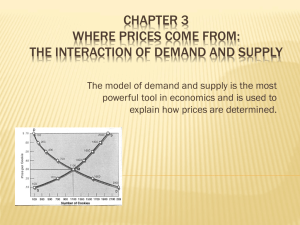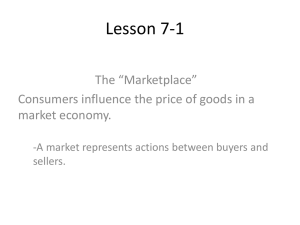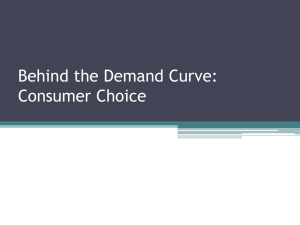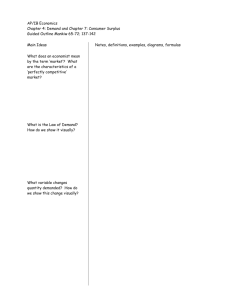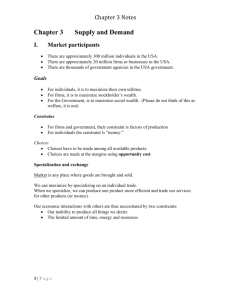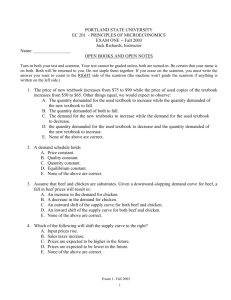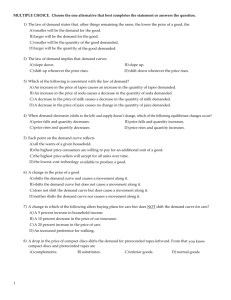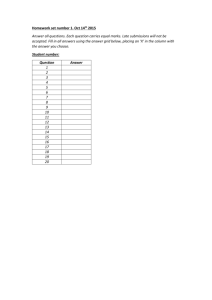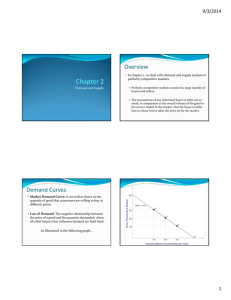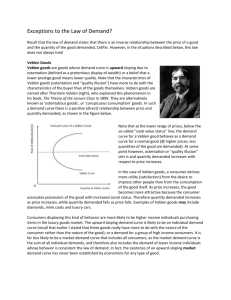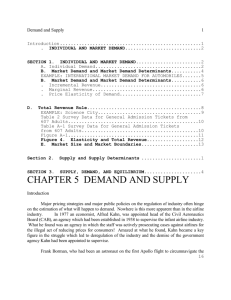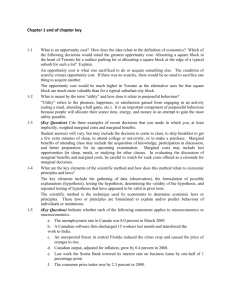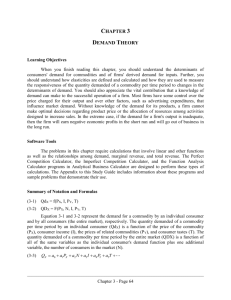Economic Concepts
advertisement
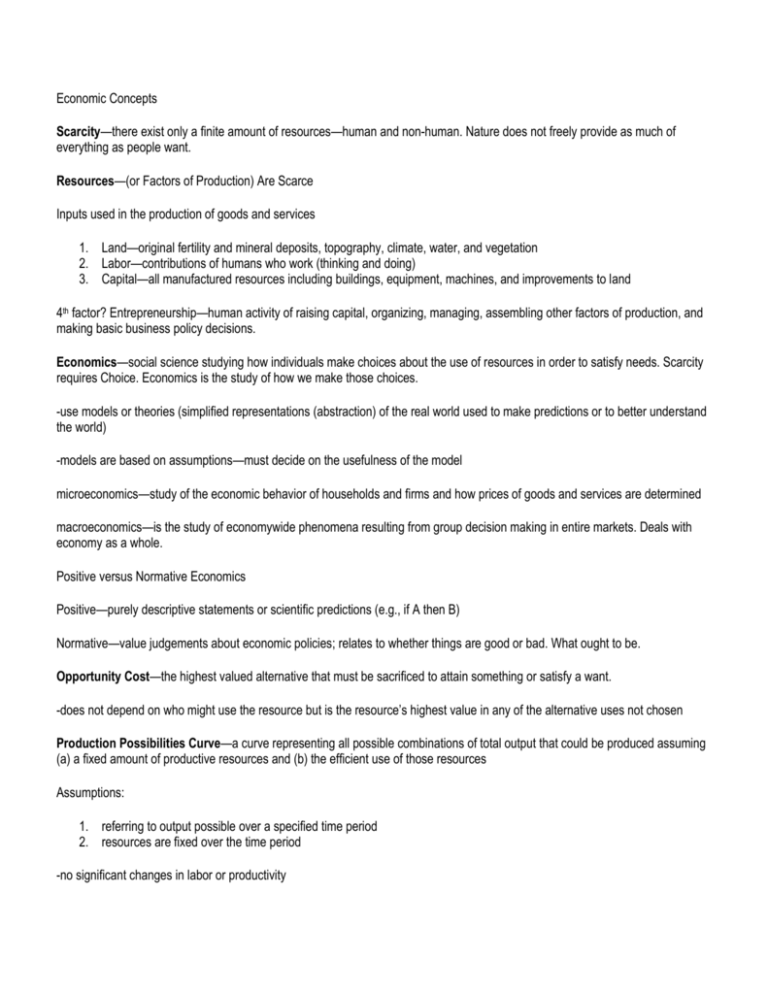
Economic Concepts Scarcity—there exist only a finite amount of resources—human and non-human. Nature does not freely provide as much of everything as people want. Resources—(or Factors of Production) Are Scarce Inputs used in the production of goods and services 1. Land—original fertility and mineral deposits, topography, climate, water, and vegetation 2. Labor—contributions of humans who work (thinking and doing) 3. Capital—all manufactured resources including buildings, equipment, machines, and improvements to land 4th factor? Entrepreneurship—human activity of raising capital, organizing, managing, assembling other factors of production, and making basic business policy decisions. Economics—social science studying how individuals make choices about the use of resources in order to satisfy needs. Scarcity requires Choice. Economics is the study of how we make those choices. -use models or theories (simplified representations (abstraction) of the real world used to make predictions or to better understand the world) -models are based on assumptions—must decide on the usefulness of the model microeconomics—study of the economic behavior of households and firms and how prices of goods and services are determined macroeconomics—is the study of economywide phenomena resulting from group decision making in entire markets. Deals with economy as a whole. Positive versus Normative Economics Positive—purely descriptive statements or scientific predictions (e.g., if A then B) Normative—value judgements about economic policies; relates to whether things are good or bad. What ought to be. Opportunity Cost—the highest valued alternative that must be sacrificed to attain something or satisfy a want. -does not depend on who might use the resource but is the resource’s highest value in any of the alternative uses not chosen Production Possibilities Curve—a curve representing all possible combinations of total output that could be produced assuming (a) a fixed amount of productive resources and (b) the efficient use of those resources Assumptions: 1. referring to output possible over a specified time period 2. resources are fixed over the time period -no significant changes in labor or productivity [Put production possibilities curve overhead up] Curve is bowed outward because of law of increasing relative cost -the opportunity cost of additional units of a good generally increases as society attempts to produce more of that good Demand and Supply Concepts Demand Law of demand: At higher prices, a lower quantity will be demanded than at lower prices, other things being equal. Alternatively, at lower prices, a higher quantity will be demanded, other things being equal. Reasons why observe law of demand: 1. Substitution effect: tendency of people to substitute in favor of cheaper commodities 2. Real-income effect: change in purchasing power that occurs when the price of a good changes Determinants of Demand The major nonprice determinants of demand are: (1) income, (2) tastes and preferences, (3) the price of related goods, (4) changes in expectations of future relative prices, and (5) population (i.e., market size). The major nonprice determinants of supply are: (1) input costs, (2) technology, (3) taxes and subsidies, (4) expectations of future relative prices, and (5) the number of firms in the industry. Substitutes: a change in the price of one causes a shift in demand for the other in the same direction (e.g. butter and margarine) Complements: a change in the price of one good causes a shift in demand for the other in the opposite direction (e.g., stereo amplifiers and speakers, nuts and bolts) Distinguish between Changes in Demand and Changes in Quantity Demanded Change in Demand—results from change in a non-price determinant of demand (curve moves) Change in Quantity Demanded—results from change in price (move along curve) Supply Law of Supply: At higher prices, a larger quantity will generally be supplied than at lower prices, all other things being equal. Reasons why observe supply law: 1. higher prices increase incentives for increasing production 2. the law of increasing costs Non-Price Determinants of Supply 1. 2. 3. 4. 5. The prices of inputs used to produce the product (lower prices, curve shifts right) Technology (improvements shift curve right) Taxes and subsidies (taxes behave as a cost, shift left, subsidies reduce costs, shift right) Price Expectations (e.g., farmers withhold crops in expectation of higher prices) Number of Firms (more firms shift to the right) Distinguish between Changes in Supply and Changes in Quantity Supplied Change in Supply—results from change in a non-price determinant of supply (curve moves) Change in Quantity Supplied—results from change in price (move along curve) Supply and Demand Together Equilibrium – a situation in which the plans of the buyers and sellers coincide so that there is neither excess quantity supplied or demanded (also called market clearing price) Stable equilibrium – a situation in which a shock disturbs the prevailing equilibrium between supply and demand, there will normally be self-corrective forces that automatically cause the disequilibrium to return eventually to equilibrium Shortage—excess quantity demanded or insufficient quantity supplied. Difference between the quantity demanded and supplied at a specific price below the market clearing price. Surplus—excess quantity supplied or insufficient quantity demanded. Difference between the quantity supplied and demanded at a price above the market clearing price. The Market or Price System and Efficiency Scarcity requires that decisions be made about how resources are to be allocated Resource allocation is solved by economic system: --what and how much will be produced --how will it be produced --from whom will it be produced market—abstract concept concerning all the arrangements that individuals have exchanging with one another (e.g., labor market, fisheries market, credit market) **in a price or market system, supply and demand determine the prices at which exchanges will take place transaction costs—all the costs associated with exchanging, including the informational costs of finding out price and quality, service record, durability, etc. of a product, plus the cost of contracting and enforcing that contract Concepts --specialization results in higher outputs --individuals and nations specialize in their comparative advantages in order to reap benefits of specialization --comparative advantages are found by determining which activities have lowest opportunity cost or alternatively stated, the activities that yield the highest return for the time and resources used --individuals respond to changes in relative prices, not absolute prices, therefore, changes in the general price level must be purged from the analysis --in a market economy, businesses seek profits. In seeking profits, businesses move resources out of declining industries into expanding industries --consumers are sovereign—they votes with their dollars Efficiency concepts Technical—the utilization of the cheapest production technique for any give output rate; no outputs are willfully wasted Economic—the use of resources that generate the highest possible value of output as determined in the market economy by consumers What the market or price system does— --leads to technical and economic efficiency --maximizes individual or personal freedom --can lead to economic growth because the rewards (profits) What the market or price systems CANNOT Do—(market failures) --capture all the costs and benefits external to an exchange (called externalities) --produce adequate public goods --equalize income distribution --ensure competition Characteristics of Perfect Competition 1. the product that is sold by the firms is homogeneous 2. any firm can enter or exit the industry without serious impediments 3. there must be large number of buyers and sellers—they act independently and no one buyer or seller has any influence on price 4. must be adequate information about prices, qualities, sources of supply Price Elasticity of Demand The elasticity of demand (ed) is a measure of the price responsiveness to the quantity demanded and is equal to the percentage change in quantity demanded divided by the percentage change in price. Because the elasticity of demand can vary depending on whether one moves up or down the demand curve, elasticities of demand are often calculated by taking an average the prices and quantities given by the following formula: ed = change in Q / change in P (Q1 + Q2)/2 (P1 + P2)/2 Determinants of price elasticity of demand 1. existence of substitutes—the closer the substitutes for a particular commodity, the greater will be its price elasticity of demand 2. importance of the commodity in the consumers budget—the greater the percentage of a total budget spent on the commodity, the greater the person’s price elasticity of demand for that commodity 3. time for adjustment in rate of purchase—the longer any price change persists, the greater the price elasticity of demand Must distinguish between the short run and the long run (long run is the time necessary for consumers to make a relatively full adjustment to a given price change) For example, short run price elasticity of demand for airline travel is .6 whereas it is 2.4 in the long run


